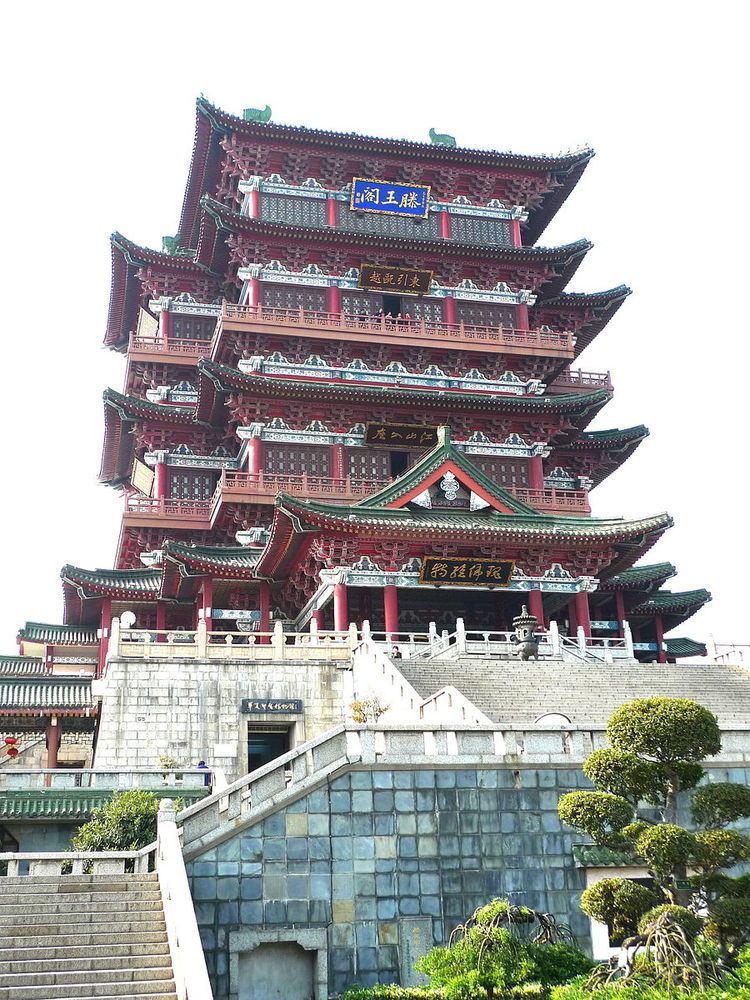Phone +86 791 8670 2036 | ||
 | ||
Similar Yueyang Tower, Yellow Crane Tower, Bayi Square, Site‑Memorial Hall of the August 1, Mount Lu | ||
Nanchang king teng pavilion
The Pavilion of Prince Teng (simplified Chinese: 滕王阁; traditional Chinese: 滕王閣; pinyin: Téngwáng Gé) or Tengwang Pavilion is a building in the north west of the city of Nanchang, in Jiangxi province, China, on the east bank of the Gan River and is one of the Three Great Towers of southern China. The other two are the Yueyang Tower and the Yellow Crane Pavilion. It has been destroyed and rebuilt many times over its history. The present building was rebuilt in 1989 on the original site. The rebuilding plan was devised by the architect Liang Sicheng,and now the Pavilion of Prince Teng is the landmark of Nanchang. There are nine floors in total. The main architectural structure is in Song dynasty wooden style, showing the magnificence of the Pavilion.
Contents
History
The Pavilion of Prince Teng was first built in 653 AD, by Li Yuanying (simplified Chinese: 李元婴; traditional Chinese: 李元嬰; pinyin: Lǐ Yuányīng), the younger brother of Emperor Taizong of Tang and uncle of Emperor Gaozong of Tang. Li Yuanying was enfeoffed as Prince Teng in 639 and spent his early years in Suzhou. In 652 he was assigned the governorship of Nanchang where the pavilion served as his townhouse. The Pavilion of Prince Teng is the only existing royal architecture in southern China. Twenty years later, the building was rebuilt by the new governor. Upon its completion, a group of local intelligentsia gathered to compose prose and poetry about the building. The most famous of these is the Preface to the Pavilion of Prince Teng (Chinese: 滕王阁序 (p=Téngwáng Gé Xùjì) by Wang Bo. This piece made the Pavilion of Prince Teng a household name in China down to the present day. The phrase 时来风送腾王阁 appears in the (Chinese: 滕王阁序 (p=Téngwáng Gé Xùjì) by Wang Bo; it means "wind comes to say goodbye to the Pavilion". This phrase is famous in the city of Nanchang. The old famous saying 藤断葫芦剪,塔圮豫章残 perfectly describes the position of the pavilion in the city of Nanchang, meaning that if the Pavilion of Prince Teng and the Shëngjin Tower fall, the treasure and resources of Nanchang will not exist any more, which shows that the Pavilion of Prince Teng is highly valued and worshiped by people of Nanchang.
The Pavilion was to be destroyed and rebuilt a total of 29 times over the next centuries. The building itself changed shape and function many times. The penultimate construction was during the Tongzhi era of the Qing Dynasty. That building was destroyed in October 1926 during the chaotic warlords era.
Recent
The present Pavilion of Prince Teng was built according to the design of architect Liang Sicheng, and was completed on 8 October 1989; now a landmark of Nanchang. The building is of reinforced concrete, but decorated in Song Dynasty style. It is 57.5 metres tall and has nine stories. The building has a total floor area of 13,000 square metres.
The building sits atop a 12-metre tall concrete platform, which is intended to symbolise the now-destroyed ancient city wall. A stainless steel tablet at the entrance is engraved with a calligraphy work of Mao Zedong. The Pavilion takes the city as its background and the river as its mirror. The whole image is as beautiful as the traditional Chinese painting.
The beautiful garden which is built in 1989 is the perfect ornament of the Pavilion. The building mainly serves tourism purposes. Apart from internal decoration, attractions include a theatre staging performances of period music, and displays of reconstructed ancient instruments. There are some restaurants and souvenir shops. The streets around the pavilion have been designed to conform with its style. This area has become the centre of Nanchang's antiques trade.
Influences
The Pavilion of Prince Teng achieved national fame through the Preface to the Pavilion of Prince Teng. As a result, it was endowed by later generations with almost legendary status as an example of magnificent architecture. When the Forbidden City was built, its corner towers were built to imitate the Pavilion of Prince Teng and the Yellow Crane Pavilion as depicted in Song Dynasty paintings. (Strangely, both pavilions are depicted identically in surviving paintings). These uniquely structured corner towers remain some of the most valued architectural treasures of the Forbidden City. The Pavilion of Prince Teng was regarded as the holy land in several dynasties in the history of China. In the mean time, it is the ancient library as well, storing a large number of precious scriptures and poems.
Construction timeline
According to Wang:
